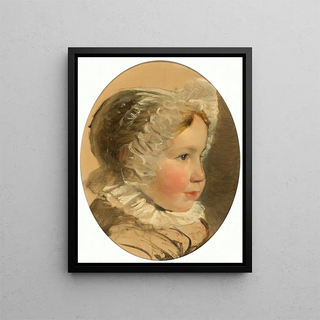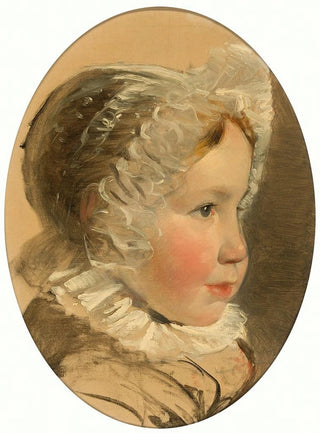Art print | Portrait of a young girl (Case Conflict) - Friedrich von Amerling


View from behind

Frame (optional)
Portrait of a Young Girl (Case Conflict) - Friedrich von Amerling – Captivating Introduction
The "Portrait of a Young Girl" by Friedrich von Amerling is a work that transcends time and space, capturing the very essence of youth and beauty. In this painting, the artist manages to create a deep emotional connection between the viewer and the subject, a young girl whose gaze appears both gentle and mysterious. The delicate composition and the color palette chosen by Amerling invite attentive contemplation, gradually revealing the richness of the feelings hidden behind this image. By admiring this piece, one is transported into a universe where innocence and curiosity intertwine, prompting reflection on the passage of time and the fragility of youth.
Style and uniqueness of the work
The uniqueness of Friedrich von Amerling's art lies in his ability to blend realism with a touch of romanticism. In the "Portrait of a Young Girl," every detail is carefully crafted, from the textures of the clothing to the reflections in the model's eyes. Amerling excels in the art of light, using plays of shadows and highlights to emphasize the delicate features of the young girl's face. This stylistic choice helps create an intimate atmosphere, almost tangible, where the viewer feels invited to enter the private universe of the protagonist. The finesse of the brushstrokes and the precision of the details testify to an exceptional craftsmanship, making this work not only a portrait but a true psychological study of its subject.
The artist and his influence
Friedrich von Amerling, an emblematic figure of the 19th century, established himself as one of the most renowned portraitists of his time. Born in Vienna, he was influenced by the artistic currents of his era, while developing a style that is uniquely his own. His approach to portraiture goes beyond mere physical representation; he seeks to capture the soul of his models. Amerling was a privileged witness to the social and cultural evolutions of his time, which is reflected in his work. His portraits, often imbued with melancholy and depth, marked a generation of artists and continue to inspire those who seek to explore the nuances of emotion.

Matte finish

View from behind

Frame (optional)
Portrait of a Young Girl (Case Conflict) - Friedrich von Amerling – Captivating Introduction
The "Portrait of a Young Girl" by Friedrich von Amerling is a work that transcends time and space, capturing the very essence of youth and beauty. In this painting, the artist manages to create a deep emotional connection between the viewer and the subject, a young girl whose gaze appears both gentle and mysterious. The delicate composition and the color palette chosen by Amerling invite attentive contemplation, gradually revealing the richness of the feelings hidden behind this image. By admiring this piece, one is transported into a universe where innocence and curiosity intertwine, prompting reflection on the passage of time and the fragility of youth.
Style and uniqueness of the work
The uniqueness of Friedrich von Amerling's art lies in his ability to blend realism with a touch of romanticism. In the "Portrait of a Young Girl," every detail is carefully crafted, from the textures of the clothing to the reflections in the model's eyes. Amerling excels in the art of light, using plays of shadows and highlights to emphasize the delicate features of the young girl's face. This stylistic choice helps create an intimate atmosphere, almost tangible, where the viewer feels invited to enter the private universe of the protagonist. The finesse of the brushstrokes and the precision of the details testify to an exceptional craftsmanship, making this work not only a portrait but a true psychological study of its subject.
The artist and his influence
Friedrich von Amerling, an emblematic figure of the 19th century, established himself as one of the most renowned portraitists of his time. Born in Vienna, he was influenced by the artistic currents of his era, while developing a style that is uniquely his own. His approach to portraiture goes beyond mere physical representation; he seeks to capture the soul of his models. Amerling was a privileged witness to the social and cultural evolutions of his time, which is reflected in his work. His portraits, often imbued with melancholy and depth, marked a generation of artists and continue to inspire those who seek to explore the nuances of emotion.






